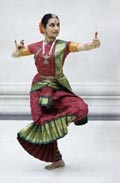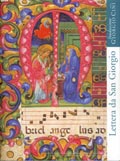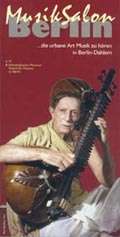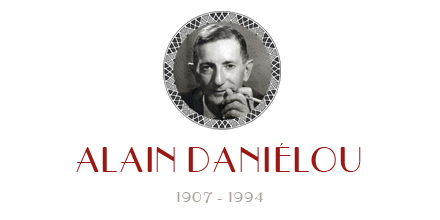NEWS
– The Alain Daniélou Centenary Year (1907-2007)
June 2007 –  June 30th, Padua: Portello River Festival. Alain Daniélou Day: Indian Bharatanatyam dance performance by Anusha Subramanyam (accompanied by voice, mridangam, nattuvangam and violin), entitled Shankara; concert of music from North India: Raga Hindustani, with Paolo Avanzo (sitar) and Stefano Grazia (tabla). Showing of the Radio Televisione Svizzera Italiana documentary La voce degli dei, on the life of Alain Daniélou.
June 30th, Padua: Portello River Festival. Alain Daniélou Day: Indian Bharatanatyam dance performance by Anusha Subramanyam (accompanied by voice, mridangam, nattuvangam and violin), entitled Shankara; concert of music from North India: Raga Hindustani, with Paolo Avanzo (sitar) and Stefano Grazia (tabla). Showing of the Radio Televisione Svizzera Italiana documentary La voce degli dei, on the life of Alain Daniélou.
July 2007 – Publication of “The Way to the Labyrinth” in Spanish; publishers Kairos, Barcelona.
August 2007 – August 2nd, Zagarolo (Rome, Italy): Garden of Palazzo Rospigliosi: A Tribute to Alain Daniélou, a performance of Indian Bharatanatyam dance by Anusha Subramanyam with the accompaniment of four musicians and a pupil.
– Zagarolo, Palazzo Rospigliosi, 3-31 August 2007.
August 3rd, Zagarolo (Rome, Italy), Palazzo Rospigliosi: Inauguration of the photograhic exhibition Alain Danielou and Zagarolo (photos by A.Danielou-R.Burnier).
September 2007 – September 22nd, Thoronet, French Riviera: Concert based on the Semantic Daniélou with Jacques Dudon’s Ensemble de Musique Microtonal du Thoronet, including the Semantic, Santour and Sitar.
-CasadeiLibri publication of Daniélou’s and Burnier’s photos of the temples of Khajuraho, Konarak and Bhuvaneshvar, as a supplement to the review Archeo.
October 2007 – October 4th, Rome (Teatro Palladium): Indian Kuchipudi dance performance by Shantala Shivalingappa, accompanied by four musicians, presented by the Margam Shivaganga.
– October 4th-24th October, Rome, awaiting confirmation: Photo Exhibition (Palazzo Poli)
– Rome, MuseoArteOrientale: India: Divina Sensualità (A. Daniélou/R. Burnier): a rare selection of shots of temple sculptures at Kajhurao, Konarak and Bhuvaneshvar. This exhibition was first shown in 1949 at the Metropolitan Museum of New York, and its current edition focuses on the relationship between body and spirit, dance and sculpture, eros and divinity. The photos are currently at the Musée pour la Photographie at Lausanne.
– October 6th, Zagarolo (RM) Italy, Gardens of Palazzo Rospigliosi: Concert of poems by Tagore set to music by A. Danielou, by F. Cassio (soprano) and U. Bonessi (piano) with choreographies in the Odissi style danced by Ileana Citaristi and recitation of the poems in Italian by Roberto Herlitzka
– October 10th, Venice (Teatro Comunale Goldoni) performance of Indian kuchipudi dance by Shantala Shivalingappa, accompanied by four musicians, presented by the Margam Shivaganga.
– October 14th, Rome (TeatroPalladium): Concert of poems by Tagore set to music by A. Danielou, by F. Cassio (soprano) and U. Bonessi (piano) with choreographies in the Odissi style danced by Ileana Citaristi and recitation of the poems in Italian by Roberto Herlitzka.
– October 16th, Valladolid (Spain); Presentation of the Spanish edition of “The Way to the Labyrinth” at Casa de la India.
– Photographic Exhibition “LA MUSICA DELL’INDIA” from October 16th – November 16th
– October 21st, Venice, Teatro Fondamenta Nuove, Concert based on the Semantic Daniélou with Jacques Dudon’s Ensemble de Musique Microtonal du Thoronet, including the Semantic, Chandravina, Sitar and Percussion
– October 23rd, Rome Teatro Palladium (October 6th AuditoriumTeatroStudio): Concert based on the Semantic Daniélou with Jacques Dudon’s Ensemble de Musique Microtonal du Thoronet, including the Semantic, Chandravina, Sruti-guitar, Sitar and Percussion.
– October 25th , Venice, Cini Foundation: Indian Music and Dhrupad Concert, with Francesca Cassio, F. Lazzarini, F. Senesi, J. Powell.
– End October: the exhibition “Lumières de l’Inde” will be on show at Hainaut as part of the nationwide event “La Fureur de lire” throughout Belgium.
– Expected publication of the volume “Il giro del mondo nel 1936”. Edition with text, drawings and photos, Casadeilibri Editore, Padova.
November 2007 – November 1st, Bergamo, Teatro Donizetti: Concert of poems by Tagore set to music by A. Danielou, by F.Cassio (soprano) and U. Bonessi (piano) with choreographies in the Odissi style by Ileana Citaristi and recitation of the poems in Italian by Roberto Herlitzka.
– November 3rd, Paris: Concert by Jacques Dudon’s Ensemble du Thoronet with the Semantic Daniélou
– November 15th Barcelona (Spain): Presentation of the Spanish edition of “The Way to the Labyrinth” at Casa Asia.
– Publication of Le Tour du monde en 1936, complete with drawings and photos. Publishers: du Rocher, Paris.
-Republication of “Le chemin du labyrinthe”, Publishers: du Rocher, Paris.
– Lettera di San Giorgio, Fondazione Giorgio Cini
Year IX, N°16, Six month publication March-August 2007.
Collections :
The Alain Daniélou archives, page 12.
« This great work has now been abandoned, but remains available for researchers who wish to follow it up in the Eastern section of the Giorgio Cini Fondation in Venice, where ma library is housed » (Alain Daniélou).
 (….) Daniélou was very interested in the developments of the wide-ranging Hindu cultural movement, finally reacting to the suffocating British yoke – whose dominance was not only political – by seeking to save their own traditions, including the arts, such as dance and music. Directly supporting this movement, Daniélou devoted himself to the creation of a school of traditional Hindu music at the University of Benares, on the strength of the reputation that he had rapidly built up in India both as a musician and musicologist. In 1950 he was appointed president of the All India Music Conference and was officially appointed by the University of Benares to create a music school together with the celebrate singer Omkarnath Thakur.
(….) Daniélou was very interested in the developments of the wide-ranging Hindu cultural movement, finally reacting to the suffocating British yoke – whose dominance was not only political – by seeking to save their own traditions, including the arts, such as dance and music. Directly supporting this movement, Daniélou devoted himself to the creation of a school of traditional Hindu music at the University of Benares, on the strength of the reputation that he had rapidly built up in India both as a musician and musicologist. In 1950 he was appointed president of the All India Music Conference and was officially appointed by the University of Benares to create a music school together with the celebrate singer Omkarnath Thakur.
Made a professor in the same institution, he organised a research centre for the literature of Sanskrit music. At the point, starting from around a hundred manuscript texts on music theory, ranging from the fifth Century BC to the 16th century, which he had gathered up till then, Daniélou began to build up an immense collection of Indian musicological index cards, now conserved in the Giorgio Cini Foundation.
As he was to write “with my group we compared the texts and classified the terminology. At that time I published several articles on music and the literature of Sanskrit music. Searching for texts required an enormous amount of work. We had to find the manuscripts in public and private libraries, make copies and then transcribe them into devanâgarî, classical Sanskrit writing, since even when using Sanskrit each province used a different system of writing. In fact it turned out to be a much too ambitious undertaking. Instead of working on a few texts whose publication, even if inadequate, would have brought me glory, we gathered documentation on over 800 works. The indices alone occupied 300,000 cards. This great work has now been abandoned, but remains available for researchers who wish to follow it up in the Eastern section of the Giorgio Cini Foundation in Venice, where my library is housed”.
Thanks to work funded by the Italian Ministry for the Heritage and Cultural Activities, begun in 2001, these small yellow-coloured index cards, compiled by hand or typewritten and often with notes both on the front and back, were scanned and transferred to digital support in order to guarantee their conservation and above all make them easier to consult for scholars and researchers. Some of these cards have some rather essential but very expressive sketches made by Daniélou himself, who was also a painter, to illustrate the features of some musical instruments, especially those reproduced in ancient Buddhist and Hindu stone reliefs.
The value of this immense collection of index cards, the largest of its kind in the world, mainly made up of a very rich anthology of quotes from works in Sanskrit, but also written in various other languages of the Indian subcontinent, lies in the fact it is a systematic census – albeit incomplete – of the main traditional treatises on Indian music (over two thirds of the cards are indices of these works) and of the phrases and periods concerning music contained in many other literary works. Moreover, the cards also include lists of Sanskrit musical terms and the names of theoreticians, artists, performers and any other people of importance for the history of music in India. And there is even more. As has rightfully been pointed out, they potentially contain the makings of a full-blown encyclopaedia of India music.
But to do justice to such a huge and absolutely unique undertaking we must also include the rest of the Alain Daniélou’s enormous musicological life work, contained in his books and numerous articles still scattered in many different reviews and periodicals, often difficult or impossible to trace. This is because his life work and archives developed in parallel over a long time and only by recomposing the various parts still scattered can the value and historical importance of Alain Daniélou’s research be fully appreciated.
The first step would be finally compile a critical edition of the musicological articles and only then tackle the difficult task of giving each index card in the archives its precise meaning in the original intentions of the scholar. The straightforward publication of the index cards as they are today would certainly be interesting and extremely useful, but would betray Alain Daniélou’s intentions, clearly expressed in the words from his autobiography quoted above.
The work is still incomplete. But on the basis of what already exists, it would be relatively easy to bring together a group of scholars with the aim of completing it and identifying and filling the lacunae. The result could then be published in a complete and systematic way and on keeping with the underlying intentions ingeniously expressed by Alain Daniélou in his writings.
Alessandro Grossato. 2007.
CONCERT
Musik im Museum: Hommage an Alain Daniélou
 Sa,09.06.2007 19:00 Uhr
Sa,09.06.2007 19:00 Uhr
Bode-Museum, Skulpturensammlung und Museum für Byzantinische Kunst
Sonderkonzert nordindischer Musik des MusikSalons Berlin anlässlich des 100. Geburtstages von Alain Daniélou
Dieses Konzert soll einen Bogen spannen zu einem der ersten, wenn nicht des ersten Konzertes, das das von Alain Daniélou gegründete Institut für Vergleichende Musikstudien (später umbenannt in Internationales Institut für Traditionelle Musik) in Berlin im Jahre 1964 veranstaltete. Dieses Konzert fand im Eichensaal des Charlottenburger Schlosses statt. Die Aufführenden waren die Brüder Dagar, die Nordindische Vokalmusik im Dhrupadstil darboten.
Die Akteure der Hommage: Die Gundecha Brüder singen in der Tradition der Dagar-Schule und gehören heute mit zu ihren wichtigsten Vertretern. Amelia Cuni hat sowohl bei R. Fahimuddin Dagar studiert als auch bei Vidur Mallik, der der Darbhanga Gharana angehört. Der Sarodspieler David Trasoff aus den USA hat bei Ali Akbar Khan in Kalifornien studiert, er wird begleitet von der Tabla-Spielerin Laura Patchen aus Berlin.
Gesang im Dhrupadstil: Amelia Cuni, Umakant und Ramakant Gundecha
Instrumentalmusik auf Sarod und Tabla: David Trasoff & Laura Patchen
Peter Pannke liest aus seinem Buch “Sänger müssen zweimal sterben“.
Concerning the Dhrupad
When Alain Daniélou returned from India to Europe in 1958 he was stupefied at Western ignorance of the music of Asian countries. In record shops, a Sicilian lullaby and Breton bagpipes stood side-by-side under the heading “Folklore” with the Imperial Japanese Court Orchestra and performers of Indian, Chinese or Iranian art music. Nothing seemed to have changed since Berlioz wrote:
“I must end by saying that the Chinese and the Indians would have music like ours if they had any at all. In this regard, however, they are still plunged in the deepest darkness of barbarity and in a childish ignorance, just revealing a few vague and feeble instincts. Moreover, the Orientals call music what we would call a racket, so that for them, as for the witches in Macbeth, what is horrible is beautiful.”
Alain Daniélou also rebelled against ethno-musicological research methods and the institutions promoting them. He felt that studying the music of the East on the basis of Western conceptions and using the Western system was a total aberration. A pianist and lieder-singer himself – as well as a player of the Indian Vina, he was well-placed to change people’s minds, which he managed to achieve by modifying ethno-musicological approaches.
With his usual enthusiasm, he launched out on a task of reassessing, promoting, spreading, conserving and developing the art music of the Orient, and particularly the great Japanese, Chinese, Indonesian, Indian and Arabic-Persian traditions.
He immediately found enthusiastic support in the just-created UNESCO, which, at the beginning of the ’sixties, asked him to produce a major record collection of such music – the “Musical Anthology of the Orient2” –, published starting from 1962 by Bärenreiter/Musicaphon of Kassel and now available on CD, published by UNESCO.
Essential support was also forthcoming from one of the past century’s major figures in international music, the Russian composer Nicolas Nabokov, a great friend of Stravinsky, Balanchine and others, and adviser of the Berlin Senate on cultural affairs, as well as director of the Berliner Festwochen.
Nabokov, who had been a friend of Daniélou’s since his wild years in Paris and had visited him during his stay in India, obtained a major grant from the U.S. Ford Foundation for the purpose of setting up in West Berlin – in the middle of the Cold War – the Internationales Institut fûr vergleichende Musik Wissenschaft and Documentation, of which Daniélou became the founder and first director in 1963.
The political aim was clear: the West desired to create a dynamic city of cultural and artistic attractions in West Berlin, an enclave in the midst of the new USSR empire.
Daniélou took advantage of the situation and his work, as indicated above, was immense. One of his first activities in Berlin was to continue the UNESCO record collections and bring to Europe groups of classical musicians from the East, the first of whom were the Dhrupad singers Mohinuddin and Aminuddin Dagar, who did a major European tour and took part in the 1964 Berlin Music Festival at the Palace of Charlottenburg.
Daniélou met with difficulties from the Indian authorities who did not wish to allow this group of singers to come, since they represented a particularly difficult and austere tradition that had been almost totally abandoned in India. Their tour was an immense success, not only allowing western audiences to discover a wholly unknown form of classical music at the highest level of quality, but also arousing new interest within India itself for this kind of singing. Nowadays, many groups of Dhrupad singers have taken up the torch: each year a festival of this unique kind of singing is held at Varanasi, and it is also performed by western singers such as Amelia Cuni in Berlin and Francesca Cassio in Italy, who also give concerts of this subtle music form.
Daniélou’s task did not come to a halt when he left the Berlin Institute in 1979. Thanks to the many groups invited, to the concerts and mini-festivals organised in Berlin, the Institute aroused much interest and produced specialists in this field who were among the first in the West to reassess this traditional art music.
Daniélou’s work is unanimously recognised and won him numerous awards in many countries, as well as the support of figures of great prestige, such as Yehudi Menuhin, a member of the Institute’s scientific council. For the three record collections published on behalf of UNESCO, Alain Daniélou also received wide recognition, including many major disk awards.
As a result of his intervention, the music of eastern countries has taken its rightful place in the world’s musical culture. No longer is Ravi Shankar considered a folk singer, or the Gagaku a folk dance. Under his stimulus, music festivals now flourish all over the western world, presenting groups of musicians and dancers that attract ever-increasing audiences.
The Dagar concert at the Palace of Charlottenburg in 1964 was certainly the first step in this great adventure, and the idea of organising another to commemorate Alain Daniélou’s one-hundredth birthday is a major tribute to this visionary artist. The Dahlem Museum and Lars Christian Koch, Werner Durand and Amelia Cuni, and Peter Pannke, faithful and constant supporters of Daniélou’s work, deserve special thanks for this superb initiative.
Jacques Cloarec, Le Labyrinthe, 7 March 2007
EXTRAITS
 Alain Daniélou, extrait du livre de James Laughlin The Way It Wasn’t, edited by Barbara Epler and Daniel Javitch, A new Direction Book.
Alain Daniélou, extrait du livre de James Laughlin The Way It Wasn’t, edited by Barbara Epler and Daniel Javitch, A new Direction Book.
We both wanted to study to study the incredible spectacles of ten thousand Hindus bathing in the filthy water of the Ganges and drinking all of it they could swallow ; the sight of the dead bodies being burned on sandalwood pyres on the ghats along the riverbank. And we had a date to call on Alain Daniélou, the Frenchmann who had become a Hindu (although his brother S.J. became a Roman Cardinal), the great scholar of Sanskrit literature and Vedic music, the author of the Bollingen book on the Hindu theologony; we visited him in his miniature Mughal palace. There he was in his dhoti, sitting on a pile of silken cushions, plucking out ragas on his sitar, a font of wisdom about everything Indian.

